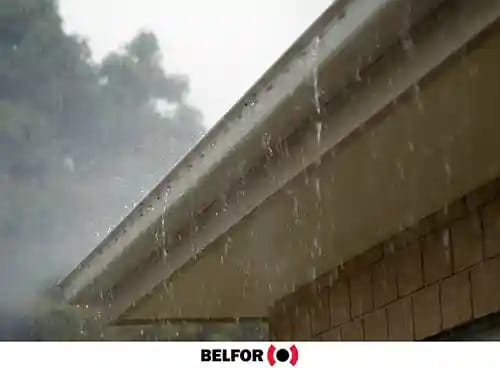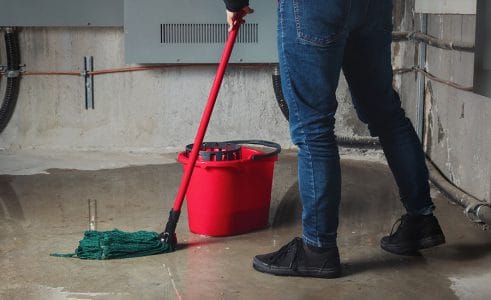A Guide to Gutter Cleaning

Gutters and downspouts play a crucial role in directing water away from a property.
When gutters become clogged, they block the intended drainage path, causing water to overflow and potentially enter the property.
This can lead to different property damage issues, including severe problems like structural failure.
Clogged Gutter Problems
Without effective and regular cleaning, debris and silt will build up in your guttering and cause blockages in your drainage system.
Water then overflows and runs against exterior walls and onto the foundation of your property.
Over time, this softens the soil around your house, which can weaken the foundation’s integrity and result in cracks and eventual structural failure.
In the shorter term, water seepage from clogged guttering can lead to mold.
As water and moisture penetrate through your walls, mold spores and bacteria can grow on wet materials. This not only damages your property, but it can also cause health issues for you and your family.
Clogged gutters — particularly during winter — can cause roof leaks, as accumulated frozen precipitation builds up against the house. When gutters and downspouts are blocked, melting snow and ice can’t drain properly.
This saturation seeps into walls and roofs, leading to water leaks in ceilings and indoor areas. In addition, melting snow and ice may refreeze, forming ice dams on the roof and gutters, blocking typical water flow.
Accumulated debris in your gutters may also attract unwanted wildlife and pests. Wet and organic materials, such as leaves and twigs, serve as a primary source of food and shelter for insects and small rodents.
If critters are attracted to the outside of your house, they’re also more likely to try finding a way into your house.
To avoid these unwanted effects, it’s helpful to understand the cleaning and protective measures you can take to properly care for your gutters.
The Cleaning Process
To prevent property damage from dirty gutters, clean them twice a year: once in the spring and once in the fall.
The number of times you need to clean your gutters each year will vary depending on where you live.
For example, if you have a high number of overhanging branches, or are surrounded by pine trees, you might want to consider cleaning your gutters every three months, due to the higher volume of debris falling into your guttering system.
You should clean your gutters if you notice these signs:
- Sagging gutters
- Dripping gutters in dry weather
- Pools of water collecting near your house, especially around the foundations
Regularly cleaning your gutters can help protect your house and help your guttering last longer. In fact, a well-maintained guttering system can stay intact and in working order for over 20 years.
How to Clean Your Gutter
Here is the step-by-step process on how to clean your gutter effectively.
1. Prepare Your Equipment
Before you begin the cleaning process, prepare all the equipment and tools you’ll need, and make sure you are wearing suitable clothing that can protect you from potential injuries.
For example, think about what type of ladder you’ll need and what the risks are, so you can keep yourself safe.
In addition to a ladder, other equipment you’ll need include:
- Thick protective gloves
- A trowel
- A stiff-bristled brush
- A flashlight
2. Clean the Downspouts
Once you have your equipment ready, clean downspouts to ensure unrestricted water drainage before moving on to the gutters.
Clear twigs, leaves, and other large debris from the base of the downspouts. Use your hose to flush water through the downspouts and remove any clogs.
If this doesn’t work, you may need to use a plumber’s snake to shift blockages.
3. Clean the Gutters
To clean the gutters, wear thick gloves and clear out all the larger debris that has accumulated in your gutters. Use a powerful garden hose to flush out most of the silt.
Tools to Help Protect Your Gutter
A wide range of products are available to help you clean out your gutters by keeping leaves and debris out of drainage systems.
Gutter Guards
Gutter guards are mesh screens that cover your gutters, costing between $7 and $10 per linear foot. They prevent larger leaves and debris from entering your gutters.
To clean them, brush off any debris on top and use a powerful hose to flush out smaller particles like mulch and silt that have passed through the mesh.
Water flows freely through the mesh of gutter guards, which block leaves, twigs, and stones. Using gutter guards prevents blockages and simplifies cleaning.
Gutter Splash Guards
Splash guards extend upward from your gutters to prevent water from splashing onto your foundation during heavy rain.
These guards are an affordable way to protect your property, costing about $5 per linear foot. They also help direct water flow and prevent buildup in unwanted areas.
Gutter Aprons
A gutter apron, which you can install along your roof’s edge at the eaves, directs water straight from the roof into the gutter, preventing it from dripping down your walls.
This installation typically costs between $5 and $7 per linear foot.
By following these gutter cleaning tips and adding protective features to your home, you can prevent costly water damage and save money in the long run.
.jpg)


